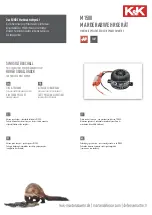
Reliance Worldwide
Corporation (UK) Ltd.
Reliance Worldwide Corporation (UK) Ltd are part of the
Australian based group of companies collectively known
as Reliance Worldwide Corporation, with the UK brand
known as Reliance Water Controls. Reliance Worldwide
Corporation (UK) Ltd is a specialist in the design,
distribution and technical support for temperature and flow
controls.
With group offices and manufacturing plants throughout
the world RWC offers a wealth of knowledge and expertise
which is reflected throughout our products. Being part of
many specialised trade associations and having our own
UKAS accredited laboratory, makes us at the forefront of
any new regulations or changes which impact the industry,
and allows for continuous product development and
innovation, within our specialised product area.
Installation
Before installing the Heatguard TMV3-8 valve ensure that
the designation of the valve matches the application, flow
rates, dynamic pressures, and temperatures must be within
the limits stated.
The Heatguard TMV3-8 valve can be installed in any
orientation provided that the hot and cold supplies
are connected to the appropriate indicated inlets. The
Heatguard TMV3-8 valve should be fitted with the supplied
union type adaptors. If isolation valves are not provided
then they should be fitted on the on the supplies to allow for
easy servicing and maintenance.
The valve should not be installed until the system has
been flushed until free of all debris. Once this is done the
strainers and check valves can be fitted into the adaptors
and the valve body installed.
The Heatguard TMV3-8 thermostatic mixing valve contains
temperature sensitive components. Soldering near the
union adaptors or main valve body must be avoided.
Commissioning
Please ensure that the commissioning of the valve is done
under normal operating conditions. The Heatguard TMV3-8
thermostatic mixing valve is supplied factory set at 38˚C.
The maximum temperature should be set
as shown in the approved specifications.
To alter this setting proceed as follows:
1. Remove the cover cap (Fig 1).
2. With both the hot and cold supplies
turned fully on and the terminal fitting
open, adjust the temperature to the
required setting. Using the adjuster tool
supplied turn the adjuster clockwise to
decrease or anti-clockwise to increase
the temperature (Fig 2). A digital hand-
held thermometer should be used
to measure the outlet temperature
correctly.
3. Once the correct outlet temperature
has been achieved the valve’s internal
mechanism should be exercised at
least 3 times by alternately isolating
the hot and cold supplies.
This will cause the piston to travel
its full stroke and will ensure that
the valve is operating correctly. If the set temperature has
drifted after this operation then the commissioning operation
should be repeated.
Once the valve has been commissioned a fail-safe shut off
test should be performed:
1. Isolate the cold supply. The flow should reduce to a
trickle within a second or two depending on site conditions.
2. Restore the cold supply and check that the set
temperature has not altered.
3. Repeat the test for the hot supply.
If either fail-safe function does not operate, ensure that
supply pressures and temperatures are within the valve’s
normal operating parameters. In addition, check that the
hot supply temperature is at least 10˚C above the valve’s
set mixed outlet temperature i.e. hot to mix differential
temperature.
Please note
: If there is a residual flow on cold shut off, then
this is acceptable providing the temperature of the seeping
water is no more than 2°C above the designated maximum
water outlet temperature setting of the valve or if the total
flow is no more than 120 ml. If this is not the case then the
valve will be slow to shut down on cold water failure.
For optimum performance it is recommended that the
dynamic pressures be as close to equal as possible. If the
dynamic pressures are outside a 10:1 ratio then a pressure
reducing valve should be fitted to the higher supply
pressure or if preferred, the lower supply pressure boosted.
When the Heatguard TMV3-8 valve has been set and
tested, re-fit the cap. A record of the commissioning settings
should be made for comparison with future performance
checks.
Maintenance
To comply with current NHS guidelines the Heatguard
TMV3-8 valve should be tested against the original
performance results 6-8 weeks after installation. If the
temperatures have remained set to within 2˚C and the fail-
safe function is operating correctly, then a six monthly cycle
of performance testing can be implemented.
Performance Checks
Performance checks that should be carried out at routine
maintenance times are:
1. Check the set temperature using a hand-held digital
thermometer.
2. Carry out the cold and hot fail-safe shut off tests.
3. If there is no significant change to the set outlet
temperature (2˚C or less change from the original settings)
and the fail-safe shut off is functioning, then the valve is
working correctly and no further service work is required.
Cleaning the Valve
1. Isolate the hot and cold supplies and remove the valve
body from the installation by undoing the 1" adaptor union
nuts.
2. Remove the check valves and strainers fitted in the
adaptors and check for damage, rinse in clean potable
water.
3. To clean the internals of the main valve body, first
remove the cap, and then carefully remove the valve
headwork by unscrewing the large hex nut.
4. Slide the piston and thermostat assembly out of the valve
body and clean all internal surfaces and ‘O’ rings clean
running water. Make note of the orientation of the parts as
they are removed so that they can be reassembled in the
correct manner (Fig 3).
5. Using a WRAS approved silicone based waterproof
grease, lightly lubricate the ‘O’ ring in the body and the
external surface of the piston.
6. After cleaning, re-assemble the Heatguard TMV3-8
valve. Exercise, reset and test the valve as laid out in the
commissioning section.
Fig 1
Fig 2




















